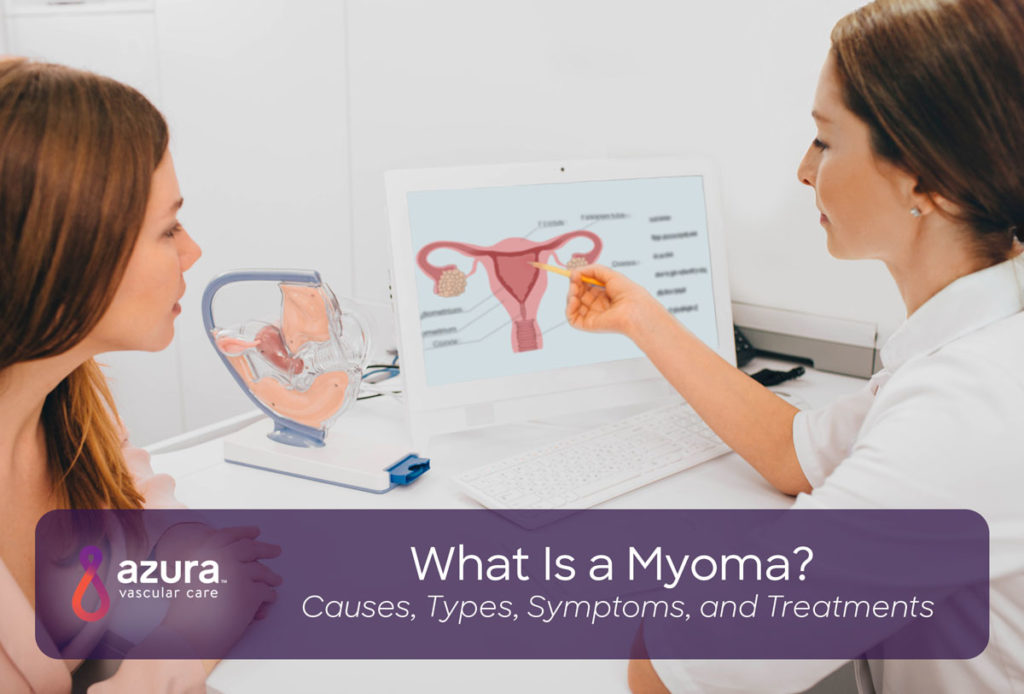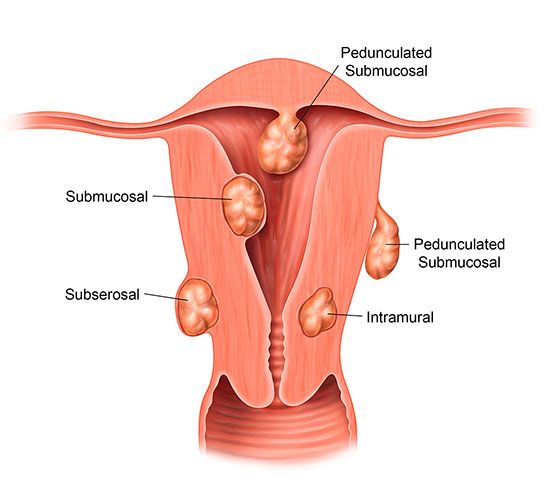
Uterine fibroids are non-cancerous tumors that grow in the uterus. They are also known as myomas. If your doctor has diagnosed you with a myoma (or uterine fibroid), it is important to know that it is the most common benign tumor of a woman’s uterus and can be treated. So, what is a myoma? Read on for more information on the causes, symptoms and treatment options.
What Is a Myoma?
Myomas are smooth, non-cancerous tumors that may develop in or around the uterus. Made partly of muscle tissue, myomas seldom develop in the cervix, but when they do, there are usually myomas in the larger, upper part of the uterus as well. (i) Myomas in this part of the uterus are also called fibroids or leiomyomas.
Doctors can see or feel most myomas during a pelvic examination. Those that cause symptoms can be removed surgically or by less invasive procedures.
The Symptoms of Myomas (a.k.a. Uterine Fibroids)
Most myomas cause symptoms at some point. (i) The most common symptom is vaginal bleeding, which may be irregular or heavy. (i) Other symptoms may include: (i)
- Heavy bleeding
- Anemia
- Fatigue and weakness
- Painful intercourse
- Pain, bleeding, or a discharge from the vagina if myomas become infected
- A feeling of pressure or a lump in the abdomen, in rare cases
- Difficulties urinating, dribble at the end of urination, or urine retention if a myoma blocks the flow of urine. Urinary tract infections are more likely to develop in women with myomas
Large myomas may partially block the urinary tract or may bulge into the vagina, called a prolapse. Sores can develop on prolapsed myomas, which may become infected, bleed, or both. Prolapsed myomas also can block the flow of urine. (i)
Myomas are more commonly called uterine fibroids, and affect 20 percent of women in their childbearing years. (ii) The signs and symptoms of uterine fibroids include: (iii)
- Abnormal bleeding
- Pelvic masses
- Pelvic pain
- Infertility
- Pregnancy complications
There are five types of uterine fibroids:
- The most common are intramural fibroids, which grow in the wall of the uterus.
- Subserosal fibroids grow in the wall on the outside of the uterus. As they grow larger, they can cause pressure on nearby organs or pain due to their size.
- Submucosal fibroids grow just beneath the uterine lining and can push into the uterus cavity, leading to heavy bleeding and other more serious complications.
- Pedunculated fibroids grow on small stalks or stems inside or outside the uterus.
- Intracavitary fibroids grow into the uterine cavity.
You may develop more than one type of fibroid. Between 70 and 80 percent of women develop a fibroid tumor by the time they reach age 50. (iv)

The Causes of Uterine Fibroids
Estrogen seems to activate the growth of uterine fibroids. In fact, during the first trimester of pregnancy, about one-third of all fibroids grow larger, but then shrink after birth. (iv) Generally, uterine fibroids shrink after menopause, but hormone therapy after menopause may cause their symptoms to continue.
Other causes of fibroids include: (iii)
- Race: Studies have found that fibroids are more common among African American women.
- Age: A study concluded that white women younger than 35 years of age had faster-growing tumors than white women older than age 45. In addition, waiting to get pregnant until age 30 or older places women at higher risk of developing uterine fibroids.
- Early menstruation: Having your first period at an early age increases the risk of developing fibroids.
- Caffeine and alcohol: A connection between alcohol and caffeine intake and an increased risk of developing uterine fibroids was uncovered in a 2016 study.
- Genetic factors: Researchers found that some specific genetic alterations are linked to fibroid growth.
- General health status: Obesity and high blood pressure also may play a role in fibroid development and growth.
- Diet: A diet rich in red meat appears to increase your chance of developing fibroids.
Treating Uterine Fibroids (Myomas)
Nearly one-third of women with uterine fibroids will seek treatment because of the severity of their symptoms. (iii) Although treatments can range from noninvasive to surgical options, the treatment choice is typically determined by considering a patient’s age—particularly if she is close to the age of menopause—and if the patient wants to have children, ruling out options such as hysterectomies. The treatment approach also depends on the number, size, and location of fibroids. However, most doctors agree that no treatment is needed if there are no symptoms due to uterine fibroids.
If you are experiencing heavy bleeding and don’t want to have a hysterectomy, you have a few options, including:
- Hormonal contraception.
- An intrauterine device.
- Antifibrinolytic
- Nonsteroidal agents.
- If you don’t want to have children, endometrial ablation is another option. During this procedure, the endometrium is destroyed using cold or heat.
- Medications called gonadotropin-releasing hormone agonist (or GnRH agonists) can shrink fibroids, but they grow back once treatment stops.
- Myomectomy, a procedure where a thin tube called an endoscope is passed into the uterus through the cervix. The fibroid is shaved and removed while leaving the uterus intact. It can reduce fibroids, but they may grow back.
- MRI-guided ultrasound surgery uses ultrasound waves to shrink fibroids and reduce heavy bleeding.
Remember, myoma, leiomyoma and uterine fibroids all refer to the same thing – a non-cancerous tumor of the uterus. Uterine fibroid embolization is a minimally invasive option that blocks the blood supply to fibroids, causing them to shrink and die. This minimally invasive outpatient procedure is uterus sparing and can treat all fibroids during a single procedure, offering less risk of complications and a quicker recovery compared to traditional surgical procedures.
To learn more about myomas and uterine fibroid embolization, download our free fact sheet, A Guide to Understanding Uterine Fibroids, or call 844-UFE-CARE (833-2273) today to schedule an appointment with a vascular specialist.
Sources:
(i) McNeeley, S.G. (2017, December). Cervical Myomas. Retrieved December 11, 2018, from https://www.merckmanuals.com/home/women-s-health-issues/noncancerous-gynecologic-abnormalities/cervical-myomas.
(ii) Healthgrades. (2019, January 5). Myoma (Fibroid). Retrieved January 16, 2019, from https://www.healthgrades.com/conditions/myoma-fibroid.
(iii) Donnez, J., & Dolmans, M. (2016). Uterine fibroid management: From the present to the future. Human Reproduction Update, 22(6), 665-686. doi:10.1093/humupd/dmw023.
(iv) Stöppler, M.C. (2018, February 28). Uterine Fibroids (Benign Tumors of the Uterus) Retrieved July 3, 2018, from https://www.medicinenet.com/uterine_fibroids/article.htm#uterine_fibroids_definition_and_facts.